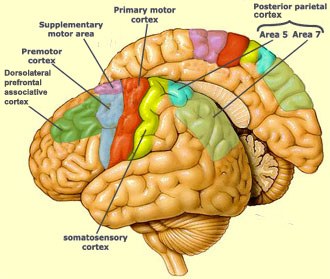Premotor cortex
 Area of motor cortex lying within the frontal lobe just anterior to the primary motor cortex. It occupies part of Brodmann area 6. It has been studied mainly in primates, including monkeys and humans.
Area of motor cortex lying within the frontal lobe just anterior to the primary motor cortex. It occupies part of Brodmann area 6. It has been studied mainly in primates, including monkeys and humans.
Because of its huge clinical potential, the importance of premotor areas for motor function itself and plastic reshaping due to tumors or ischemic brain lesions has received increased attention.
Functions
The functions of the premotor cortex are diverse and not fully understood. It projects directly to the spinal cord and therefore may play a role in the direct control of behavior, with a relative emphasis on the trunk muscles of the body. It may also play a role in planning movement, in the spatial guidance of movement, in the sensory guidance of movement, in understanding the actions of others, and in using abstract rules to perform specific tasks. Different subregions of the premotor cortex have different properties and presumably emphasize different functions.
The premotor cortex is now generally divided into four sections.
First it is divided into an upper (or dorsal) premotor cortex and a lower (or ventral) premotor cortex. Each of these is further divided into a region more toward the front of the brain (rostral premotor cortex) and a region more toward the back (caudal premotor cortex). A set of acronyms are commonly used: PMDr (premotor dorsal, rostral), PMDc, PMVr, PMVc. Some researchers use a different terminology. Field 7 or F7 denotes PMDr; F2 = PMDc; F5=PMVr; F4=PMVc.
